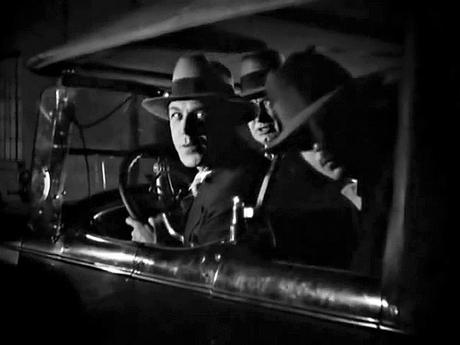
I hadn’t seen Underworldbefore, but I knew enough about it to be intrigued. To begin with, it was directed by master filmmaker Josef von Sternberg, a man of remarkable cinematic acumen who is usually only remembered today for having discovered Marlene Dietrich and stage-managed her rise to stardom. Also of interest when considering the subject of outlaws on film, Underworld was, to quote its introductory title, “…unusually bold both in subject matter and in treatment at the time it was made. It introduced a fashion for gangster pictures.” Specifically, the film, an immediate hit, is credited with establishing many conventions for what would emerge as the gangster genre a few years later, in the early sound era. Another attraction Underworld held for me was that genius costume designer Travis Banton, who would become Paramount’s Chief Designer and go on to mentor Edith Head, costumed the film. For leading lady Evelyn Brent, starring as “Feathers McCoy," he created a bedazzling closet full of trend-setting feather-bedecked clothing and head wear of all kinds. And so, one day last week I sat down to watch Underworld a few times and begin my post for the Classic Movie Blog Association's Fall 2018 OUTLAWS blogathon.
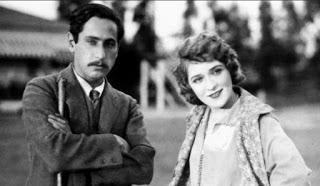
Josef von Sternberg and Mary Pickford in 1924
When Paramount assigned him to direct Underworld, Josef von Sternberg, a controlling and exacting man driven by inherent artistic virtuosity and ambition, made an exerted effort to create a film that would appeal to a mainstream audience. At this point in his career, then still in his early 30s, he had already experienced a rapid rise and fall in Hollywood. Not long after his arrival, he was being hailed as the film capital's "greatest director yet." But he had recently hit a calamitous speed-bump on a doomed project with Charlie Chaplin. Underworld would mean another chance, maybe his last, to have a career in Hollywood. In his 1965 autobiography, the director described the hostility aimed at Underworld before, during and after the film was made. He contended that Ben Hecht, who penned the story (and would go on to win his first Oscar for it), was so displeased with the finished picture that he wanted to disassociate himself ("You poor ham," his telegram to von Sternberg said, "take my name off the film."). The director also claimed that Paramount's head of sales went so far as to wire studio chief B.P. Schulberg asserting that "it was the unanimous opinion of the entire sales department that the film could not be sold, and to shelve it."By the time Underground was set to open in New York City in August 1927, it was scheduled for a one week run at the Paramount Picture Palace. According to von Sternberg, the film opened without publicity "at ten in the morning to avoid a review by the press, no critic being awake that early." Within a few hours Times Square was gridlocked by the crowd trying to get into the theater. The theater was forced to stay open all night to accommodate the swarm, "thus inaugurating the era of gangster films and exhibitions of films around the clock," von Sternberg wrote. The film would move to the nearby Rivoli for an unlimited run.
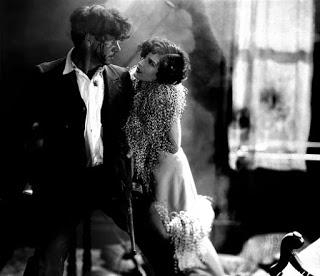
George Bancroft (Bull Weed) and Evelyn Brent (Feathers McCoy)
Underworld follows the destiny of gangland boss “Bull Weed” (George Bancroft). Bull is a rough and tumble brute of a mobster, but von Sternberg, who worked on script revisions with art director Hans Dreier (Oscar winner for Sunset Boulevard), would also endow the character with a prevailing strain of humanity. This change, along with others, including a modified ending in which the thug determines rather than is handed his fate, did not sit well with author Hecht, a former Chicago newspaperman who'd covered the mob at close hand.The film opens as Bull Weed makes his getaway from a bank robbery and encounters a drunken derelict on the street. It's his former lawyer and Bull will decide to bring him into his gang and nickname him “Rolls Royce” (Clive Brook). Rolls Royce becomes the brains of the gang and is fiercely loyal to Bull for saving him from the gutter. But he begins to fall for Bull's girl, a flapper/moll named "Feathers," who wears lots of them.
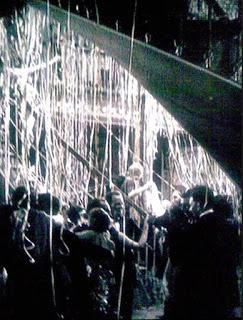
The gangster's ball
Third-billed Bancroft is dynamic and expressive in the central role as Bull Weed, a not unlikable, hulking alpha male. Top-billed Brook is cast to type as the "noble gangster," intelligent, restrained and honorable, and he fills the slot of romantic leading man ably enough. Evelyn Brent is appealing as the diminutive but feisty Feathers, object of both men's affection.Things go off the rails for Bull at the end of a raucous gangster's ball when a rival crook attempts to have his way with Feathers. Bull finds out, intervenes and then goes after the man. In the end, Bull Weed will die, and Rolls-Royce and Feathers will survive, but not before Bull doubts the pair and plots revenge. He seeks and finds them, but once he realizes their loyalty to him and observes their love for each other, he relents and surrenders to the police.
Underworld was a smash, the kind of success that invites replication of storyline, character types, plot devices, art direction, photography and other elements that in combination form a template (and quite a few tropes). But this mobster tale, despite its narrative, tempo and bullet-riddled interludes, is neither hard-boiled nor cold-blooded in style or tone. That would come later, with the epic genre films of pre-code early sound: Little Caesar (1931), The Public Enemy (1931), Scarface (1932), also penned by Hecht, and those that followed.
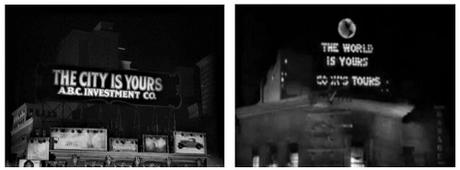
Left: billboard in Underworld (1927); right: billboard in Scarface (1932)
Ben Hecht would complain that von Sternberg had given his story "sentimental touches." Hecht knew his subject well and was a very fine writer but his sensibility and orientation were entirely different from von Sternberg's, who approached film as an artist committed to his own personal vision. The film that brought him to the attention of Hollywood, The Salvation Hunters (1925), had been called "the first avant garde feature film" as well as "an artistic masterpiece." Assistant director Robert Florey, who worked with him on films in 1925 and 1926, would declare that the director, "never shot one foot of film indifferently." Von Sternberg's close attention to detail, inclination toward experimentation and dedication to artistry is plain in every frame of Underworld. Where Hecht might have preferred a snappier, hard-edged treatment, von Sternberg would conceive something visually luxuriant and quixotic in spirit.
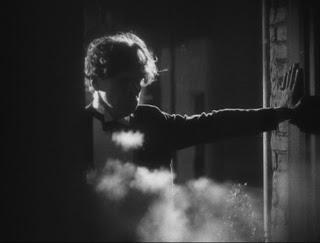
Bull Weed's last stand
Film critic Andrew Sarris, who wrote a slender but insightful book on the director's work for New York's Museum of Modern Art, termed Underworld a "pre-gangster" rather than "proto-gangster" film (it is now also called proto-noir). Sarris would regard Bull Weed as von Sternberg's "Byronic hero," and point out that the director, not prone to exploring social issues, would, as he always did, "concentrate on the themes which most obsess him and his heroes: love, and faith, and falsehood."With Underworld, von Sternberg managed to concoct an artful commercial hit. He would be rewarded with Paramount's annual bonus of $10,000 given to the director who made "the best picture of the year" and join the ranks of Hollywood's leading directors. This would last...for a while.
Watch Underworld here:
Click here for links to all contributions to the Classic Movie Blog Association's Fall 2018 blogathon, OUTLAWS!
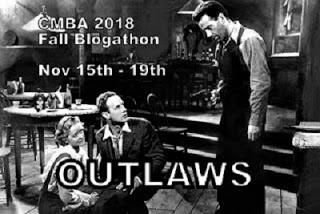
References:
Fun in a Chinese Laundry by Josef von Sternberg (MacMillan, 1965)
The Films of Josef von Sternberg by Andrew Sarris (Museum of Modern Art, New York, distributed by Doubleday, 1966)
Criterion Collection DVD visual essay by UCLA film professor Janet Bergstrom (2010)

